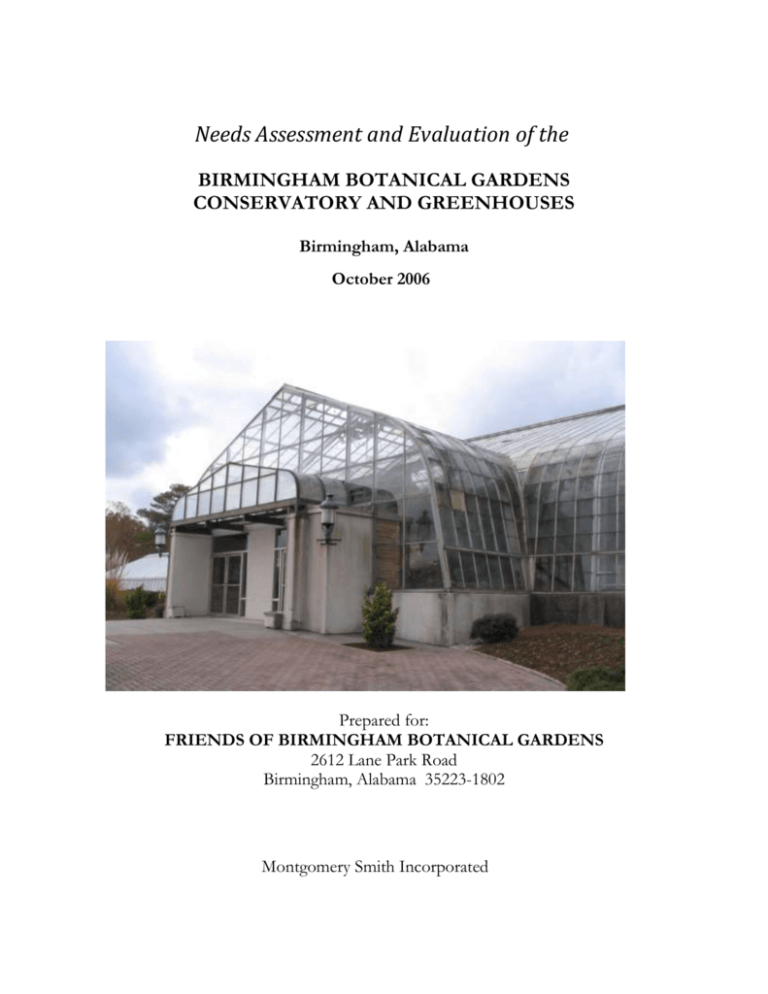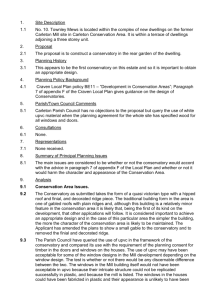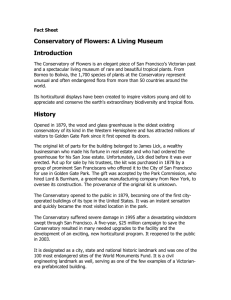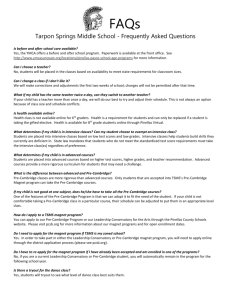Intro from BBG Evaluation
advertisement

Needs Assessment and Evaluation of the BIRMINGHAM BOTANICAL GARDENS CONSERVATORY AND GREENHOUSES Birmingham, Alabama October 2006 Prepared for: FRIENDS OF BIRMINGHAM BOTANICAL GARDENS 2612 Lane Park Road Birmingham, Alabama 35223-1802 Montgomery Smith Incorporated I. DESCRIPTION OF THE CONSERVATORY AND GREENHOUSES The Conservatory and greenhouse complex was one of the original components of the first master plan commissioned in 1960 by Birmingham Mayor James W. Morgan for the establishment of the Birmingham Botanical Gardens. The Botanical Gardens is situated on a 67 acre site with the Conservatory sited in the front eastern portion of the property in a relatively level basin area with gardens established upward on three sides, north, south and west. [See photo 1] The Formal Garden, which sits west of the Conservatory, separates the Garden Center structures from the Conservatory complex. [See photo 2] The conservatory was designed and fabricated by Lord and Burnham Company, Inc. of Irvington, New York and was erected by the greenhouse sub-contractor Rough Brothers, Inc. of Cincinnati in 1962-63. Lord and Burnham Co. dominated the conservatory and greenhouse industry for more the one hundred and thirty years, 1856 to 1987, and were responsible for designing and building other great conservatories such as New York Botanical Garden, U.S. Botanical Garden, Golden Gate Park Conservatory, Phipps Conservatory and Longwood Gardens. Rough Brothers Inc., founded in 1932, acquired the last of the Lord and Burnham division from Burnham Corporation in 1987 and is currently the largest greenhouse design manufacturer in the country. The company has restored many of the 19th century Lord and Burnham conservatories across the United States. The main structures and glazing for the Birmingham Botanical Gardens’ (BBG) Conservatory have not been altered or upgraded over the last forty-four years for maintenance or usage reasons except for a partial re-sealing of the roof glass lites in the 1980’s and a re-working of the front entrance vestibule – altering the original stone entrance with a stucco enclosure and canopy. [See photo 3] The structure still retains 24” inch width glass spacing, lapped annealed glass glazing with curved glass eaves, aluminum extruded glazing rafters and caps and manually operated sidewall vent sash frames. The main steel structure design is a modern “rigid frame” or moment frame style that Lord and Burnham had been designing since the early 1950’s – a departure from the traditional built up truss design incorporating numerous small components. An early example of this modernist style is the 1954 Lord and Burnham replacement conservatory at Garfield Park in Indianapolis, Indiana. This wide span style was considered more modern and provided larger open spaces within the conservatory both in height and width without truss components. This “opening-up” of the internal space and the use of untraditionally wide glass on the entrance vestibule are significant features to this Conservatory and place it in a period of progressive change in glasshouse design. [See photos 4 & 23] The foundation, piers and knee walls are of concrete and masonry construction, all typical of the time of construction. Another unique design incorporated in the BBG Conservatory is the use of a tilted sidewall. Traditional sidewalls are straight and plumb – the sidewalls here are slanted from the eave outward to the knee-wall at about a 15-degree angle. Reasons for doing this, other than for style, are unclear but reasonable theories include that it would increase floor plan space and could help with condensation control on the face of the glass. [See photos 5 & 24] The floor plan of the Conservatory covers nearly 11,500 square feet and is very traditional having a large show house in the middle with an enhanced entrance vestibule, two lower profile show houses (wings) flanking both sides and a glass connector structure at the rear of the main show house connecting the Conservatory to the head house (potting shed) work area, which covers about 3,250 square feet. All of the glasshouse structures – making up three separate climate zones – utilize passive ventilation by means of operable sidewall and roof vent sashes. [See photo 6] Heating is provided through radiant fin tubes around the perimeter of the glasshouses and the main Conservatory space incorporates four additional fan coil unit heaters suspended at the eave line - all supplied with hot water from boilers located in the head house. [See photo 7] A wet pad/fan system was added for cooling in the Camellia Show house [See photo 8] and evaporative wet pad cooling units were added for cooling in the main Conservatory space. Shading for the summer months has been accomplished by manually applying and removing white liquid shading compound to the exterior roof surfaces – an age old practice.[See photo 9] The six support greenhouse structures used for production and plant storage are of different construction and originate from three different greenhouse manufacturers: Lord and Burnham, National Greenhouse and IBG Greenhouse Co. Only the Lord and Burnham production greenhouse (Blue Ribbon ® brand name) is directly connected to the Headhouse facility and may have been the only production greenhouse included with the original construction package. This greenhouse is also the only one divided into separate compartments. The other greenhouses seem to be from later construction endeavors.[See photo 10] Most of the The IBG “pipe frame” greenhouse, such as No.# 5 behind the Camellia Show house, was salvaged from another location and re-erected in the recent past. The glazing on this structure was removed recently for safety reasons. The production greenhouses are passively ventilated and five houses have had exhaust fans with wet pad cooling systems added. Heating is accomplished with gas fired unit heaters of different brands and styles – some are jet tube design, others are straight blower units in five of the six greenhouses. Hot water supplied radiant tubes and a fan coil unit heater heat the National greenhouse at the far southwest corner of the group. Shading at present is done with polypropylene shade fabric stretched over the roof surfaces. Plant benching exists in most of the range of greenhouses.[See photo 11] The headhouse structure is conventional masonry block construction with steel roof trusses and built-up bituminous roof construction. Heating is provided via gas fired unit heaters mounted overhead. Summer cooling is provided by large portable fans which are moved into the space when needed. The headhouse houses three boiler units, back-up emergency power generators, two office areas, staff and public restrooms (accessed from outside the headhouse), work space and storage space. The remainder of the Conservatory site contains shadehouse (lath house) structures, garage structures, materials storage areas, parking and drive areas and an underground gasoline fuel storage tank with tank house. [See photos 12 & 13] II. OBSERVATIONS AND CRITICAL CONCERNS EXECUTIVE SUMMARY The overall structural condition of the conservatory complex is good considering age and location. The lack of comprehensive maintenance initiatives over the last 30 years have taken a toll on the glazing [See photo14] and mechanical systems in the greenhouses and these systems are currently in poor if not inoperable condition. The design of the conservatory glasshouses, the setting of the structures, the relatively large support facility and the availability of space to expand or reorganize the complex are all highly valuable assets and by comparison to many other botanical gardens across the United States quite enviable. Our opinion of the Conservatory is that it is an excellent and rare example of late century Lord and Burnham design, is a stable and robust structure and is certainly worthy of restoration. The investment of time, planning and funds would most definitely be well spent and would result in a completed facility far better that the original effort in 1962. The most immediate concerns are visitor and staff safety and access issues. In summary: annealed glass overhead, lack of emergency lighting and exit direction, possible presence of asbestos and lead, ADA noncompliant aggress/egress – walks and paths. The most highly deteriorated systems impacting both the growing environment and the visitor are the failed glazing system and the mostly inoperable ventilation system. The mechanical systems – heating, electrical and emergency power – are mostly operational but in various stages of disrepair and condition.( One boiler is completely shut down, another has had to breakdowns already this season and the hot water feed piping for the Cactus room has broken apart due to corrosion.) These current conditions are due to age and also due to the lack of a consistent maintenance program. The goal for these systems is to have uniformity in the equipment and distribution systems throughout the complex and to have all of the operating systems connected to a central computerized environmental controller to manage and record all three (or more including the production greenhouses) of the different greenhouse environments in the complex. This facility in whole, by any measure, is difficult to maintain due to building type, the harsh internal environments and due to the non-traditional, and often isolated, maintenance projects and programs. The primary effort at present should be to select and prioritize all of the tasks involved in a complete restoration and reorganization of the complex. The next step would be to put those prioritized tasks into a realistic and long-range schedule. During this process of prioritization it will become clear that certain issues may in fact need a temporary, stopgap, solution to even maintain the collections through the next few seasons – the heating system for example. Finally it is important to emphasize that projects related to the restoration of the actual structures and systems need to be coordinated with programmatic reorganizations, even if long range, to efficiently complete targeted goals with minimum costs, time schedule and disruption to the visiting public.










